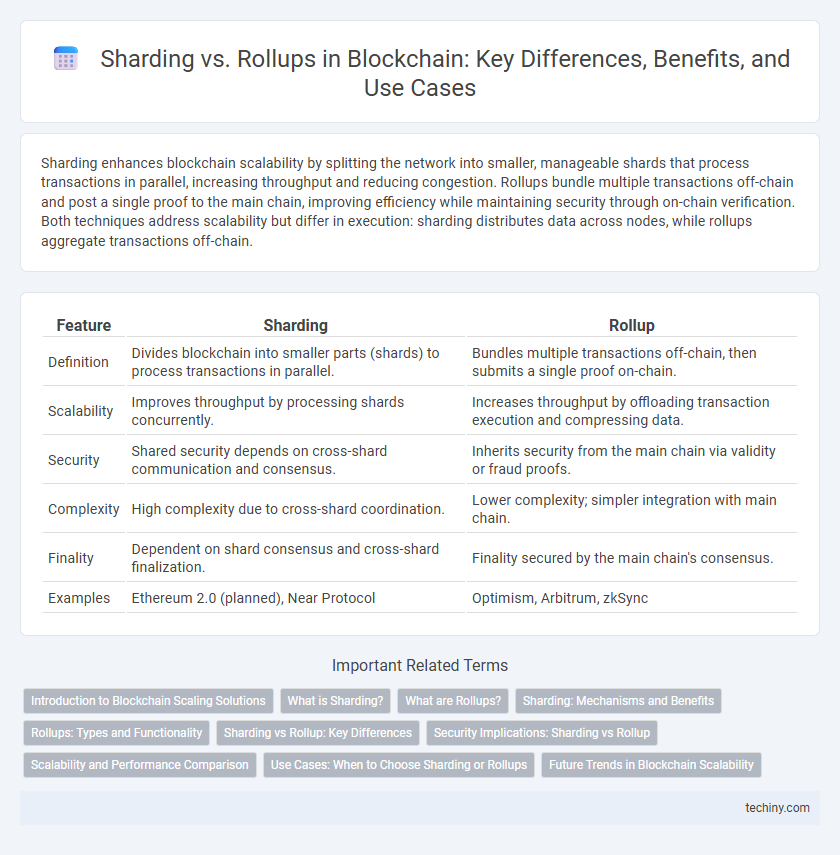Sharding enhances blockchain scalability by splitting the network into smaller, manageable shards that process transactions in parallel, increasing throughput and reducing congestion. Rollups bundle multiple transactions off-chain and post a single proof to the main chain, improving efficiency while maintaining security through on-chain verification. Both techniques address scalability but differ in execution: sharding distributes data across nodes, while rollups aggregate transactions off-chain.
Table of Comparison
| Feature | Sharding | Rollup |
|---|---|---|
| Definition | Divides blockchain into smaller parts (shards) to process transactions in parallel. | Bundles multiple transactions off-chain, then submits a single proof on-chain. |
| Scalability | Improves throughput by processing shards concurrently. | Increases throughput by offloading transaction execution and compressing data. |
| Security | Shared security depends on cross-shard communication and consensus. | Inherits security from the main chain via validity or fraud proofs. |
| Complexity | High complexity due to cross-shard coordination. | Lower complexity; simpler integration with main chain. |
| Finality | Dependent on shard consensus and cross-shard finalization. | Finality secured by the main chain's consensus. |
| Examples | Ethereum 2.0 (planned), Near Protocol | Optimism, Arbitrum, zkSync |
Introduction to Blockchain Scaling Solutions
Sharding and rollups are key blockchain scaling solutions designed to enhance transaction throughput and reduce latency. Sharding partitions the blockchain into smaller segments called shards, enabling parallel processing of transactions across multiple nodes, which significantly boosts scalability. Rollups, meanwhile, batch multiple transactions off-chain and submit compressed proofs to the main chain, optimizing data storage and improving overall network efficiency.
What is Sharding?
Sharding is a blockchain scalability solution that divides the network into smaller, manageable pieces called shards, each processing its own transactions and smart contracts independently. This parallel processing significantly increases the overall throughput and efficiency of the blockchain by distributing the workload across multiple nodes. Sharding enhances decentralization while maintaining security through cross-shard communication protocols and consensus mechanisms.
What are Rollups?
Rollups are Layer 2 scaling solutions for blockchain that bundle multiple transactions into a single batch, which is then submitted to the main Ethereum chain, reducing on-chain data and gas fees. They execute transactions off-chain while relying on the mainnet for security and data availability, enabling higher throughput without compromising decentralization. Rollups come in two main types: Optimistic Rollups, which assume transactions are valid unless challenged, and zk-Rollups, which use zero-knowledge proofs to verify transaction accuracy instantly.
Sharding: Mechanisms and Benefits
Sharding in blockchain divides the network into smaller, manageable segments called shards, enabling parallel processing of transactions and smart contracts which significantly increases throughput and scalability. Each shard operates independently yet remains interconnected through a consensus protocol, preserving security and data integrity across the entire blockchain. This mechanism reduces latency and enhances efficiency by distributing workload, making sharding a crucial innovation for scaling decentralized networks.
Rollups: Types and Functionality
Rollups in blockchain are scaling solutions that process transactions off-chain while maintaining security through on-chain data availability. There are two primary types: Optimistic Rollups, which assume transactions are valid and use fraud proofs to challenge incorrect ones, and Zero-Knowledge (ZK) Rollups, which generate cryptographic proofs to verify transaction validity instantly. These rollups significantly enhance throughput and reduce gas fees by batching multiple transactions into a single proof submitted to the main blockchain.
Sharding vs Rollup: Key Differences
Sharding partitions a blockchain network into smaller, manageable segments called shards, enabling parallel transaction processing and improving scalability by distributing workload across nodes. Rollups bundle multiple transactions off-chain into a single batch, posting transaction data to the main chain for increased throughput without compromising security. The key difference lies in sharding's network-level data distribution versus rollups' off-chain transaction aggregation, impacting scalability, security, and decentralization differently.
Security Implications: Sharding vs Rollup
Sharding divides a blockchain into smaller shards that process transactions in parallel, increasing scalability but exposing the network to risks like cross-shard communication attacks and shard-specific validators being compromised. Rollups execute transactions off-chain while publishing data on-chain, maintaining Ethereum's security model by leveraging its consensus and data availability, thereby reducing attack surfaces compared to sharding. Security considerations also highlight that sharding requires complex mechanisms to ensure data availability and prevent shard takeover, whereas rollups benefit from Ethereum's robust security guarantees.
Scalability and Performance Comparison
Sharding enhances blockchain scalability by partitioning the network into smaller, manageable segments called shards, each processing transactions in parallel, thereby increasing throughput and reducing latency. Rollups improve performance by aggregating multiple transactions off-chain and submitting a single proof to the main chain, significantly lowering on-chain data load while maintaining security through on-chain validation. Both technologies aim to address scalability challenges, with sharding offering horizontal scaling across the network and rollups optimizing transaction execution through off-chain computations.
Use Cases: When to Choose Sharding or Rollups
Sharding enhances blockchain scalability by distributing data and transactions across multiple nodes, making it ideal for applications requiring high throughput and decentralized data storage, such as large-scale DeFi platforms and NFT marketplaces. Rollups bundle and process multiple transactions off-chain before submitting a single proof to the main chain, optimizing for lower gas fees and faster finality, which benefits use cases like microtransactions, gaming, and payment channels. Choosing sharding or rollups depends on the demand for decentralization versus transaction efficiency, with sharding favored for long-term scalability and rollups for immediate cost reduction and speed.
Future Trends in Blockchain Scalability
Sharding and rollups represent two pivotal approaches to blockchain scalability, with sharding dividing the blockchain into smaller, manageable shards to increase transaction throughput, while rollups execute transactions off-chain and submit compressed data back to the main chain. Future trends indicate hybrid models combining sharding's on-chain parallelism with rollups' off-chain efficiency to further enhance scalability and reduce latency. Advancements in Layer 2 solutions, cross-shard communication, and zero-knowledge proofs are forecasted to drive the next generation of high-performance, scalable blockchain networks.
Sharding vs Rollup Infographic

 techiny.com
techiny.com